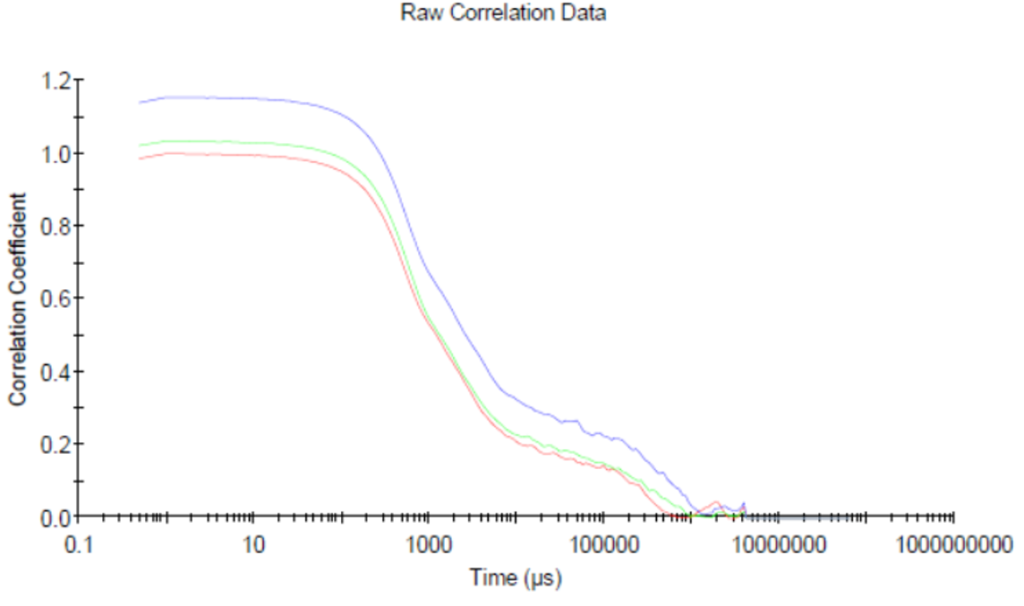 Dynamic Light Scattering (DLS)
Dynamic Light Scattering (DLS)
Overview
DLS is a sophisticated and versatile analytical technique that offers unparalleled insights into the behavior of particles and molecules at the nanometer scale.
At its core, Dynamic Light Scattering (DLS) harnesses the fascinating properties of light to delve into the nanoscale world. By shining a laser beam onto a sample containing particles or molecules in motion, we capture the scattered light patterns resulting from their Brownian motion. These patterns, known as intensity fluctuations, hold valuable information about the size distribution and diffusion dynamics of the particles. Through advanced mathematical analysis of these fluctuations, we can precisely determine particle sizes, diffusion coefficients, and interactions, providing a window into the dynamic behavior of nanoscale entities. DLS enables us to explore the ever-changing world of nanoparticles and molecules, making it an indispensable tool in scientific research and industrial applications.
DLS finds its application in a wide spectrum of scientific disciplines and industries. In pharmaceuticals, it aids in optimizing drug formulations and assessing protein aggregation, critical for drug stability and efficacy. Material scientists use DLS to explore nanoparticle properties, essential in the development of advanced materials with tailored properties. In the realm of biology, DLS unveils the mysteries of biomolecule behavior, contributing to breakthroughs in molecular biology and biophysics. It is also one of important methods to understand the polymer materials.
Our DLS service empowers researchers, scientists, and engineers to harness the full potential of this cutting-edge technology. Whether you’re investigating nanoparticle behavior, characterizing macromolecules, or optimizing colloidal systems, our state-of-the-art instrumentation and expertise ensure precise and insightful results. We work alongside you, offering tailored DLS solutions to address your unique research and development challenges.
Services
- Size distribution of particles in solution
Pricing
- $300/sample that includes 3 images. 4 -6 days of turnaround.
- For a comprehensive overview of our pricing structure, please log in to the Bee Portal.
Equipment
The Zetasizer Nano ZS is a high performance two angle particle, zeta-potential, and molecular size analyzer for the enhanced detection of aggregates and small particles. Samples may be measured at very low or high concentration using dynamic light scattering with ‘NIBS’ optics. Size may be measured in the range of 0.3nm to 10um. Zeta-potential may be measured in the range of 3.8nm to 100um. The flow mode option enables the system to be connected to an SEC or an FFF system to use as a detector for the size of proteins or nanoparticles. The MPT-2 Autotitrator allows the study of the effect of changes in pH, conductivity, or any additive to be automated. A range of disposable and reusable cells are available to optimize the measurement in terms of sample volume, concentration, and flow measurement.

FAQ
A: Dynamic Light Scattering (DLS) is an analytical technique that uses laser light to study the movement and characteristics of particles or molecules in a liquid suspension, providing insights into their size and dynamics at the nanoscale.
A: DLS measures the fluctuations in scattered light caused by the Brownian motion of particles. These fluctuations are analyzed mathematically to extract information about particle size, with larger particles causing slower fluctuations.
A: DLS is widely used in pharmaceuticals, materials science, biology, and chemistry for applications such as nanoparticle characterization, protein aggregation studies, stability assessments, and biomolecular research.
A: DLS is effective for particles and molecules in the size range of 1 nanometer to several micrometers, making it ideal for studying nanoparticles, colloids, and macromolecules.
A: Yes, DLS can handle polydisperse samples (those with a range of particle sizes) and provides information about the distribution of sizes within the sample.
A: DLS can also yield information about particle size distribution, diffusion coefficients, and interactions between particles or molecules.
A: Yes, DLS is non-destructive and does not alter the integrity of the sample, making it suitable for studying delicate biomolecules and materials.
A: DLS analysis can be completed relatively quickly, with typical measurements taking anywhere from a few seconds to a few minutes, depending on the sample and instrument.
A: Yes, DLS is employed in quality control to ensure product consistency in industries such as pharmaceuticals, cosmetics, and nanomaterial production.
A: DLS offers several advantages, including its ability to analyze samples in their natural liquid state, suitability for a wide size range, non-invasive nature, and rapid measurement times. Comparing DLS to other techniques can help you choose the right method for your specific research or quality control needs.

